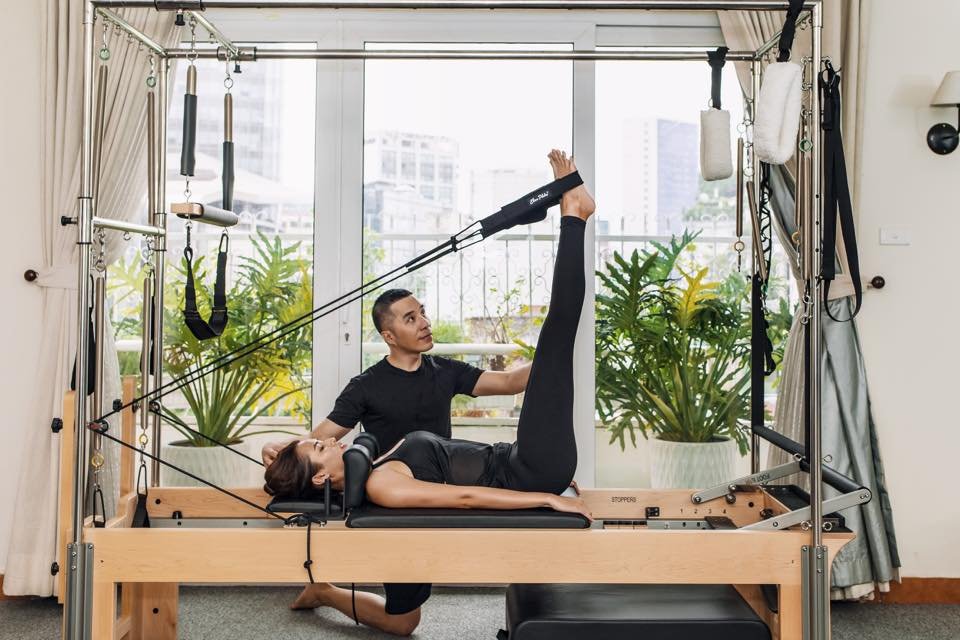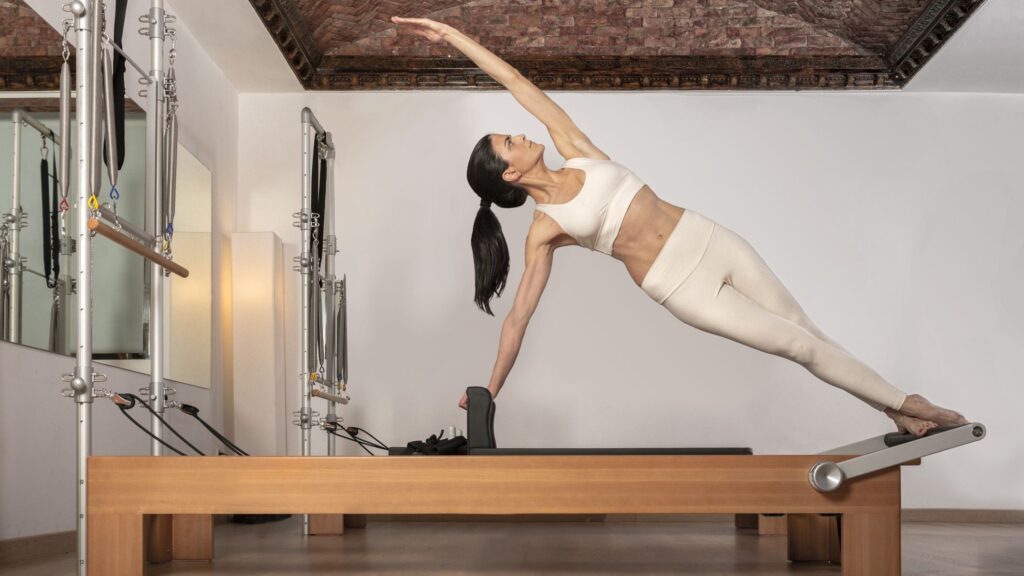What is Pilates? 15 benefits of practicing Pilates
18/03/2025In Vietnam, the concept of Pilates is still quite strange. Pilates is used by many foreign stars to keep their bodies in good shape. Join MBS to learn about the concept of Pilates? Who can practice Pilates and the health benefits it brings through the content below!
What is Pilates?
Simply put, Pilates is an exercise method that combines the body and consciousness to improve strength and flexibility in the joints and the muscle groups surrounding the joints. This helps you improve your ability to feel your muscles and increase concentration during exercise.
History of Pilates
These core-strengthening exercises were created by Joseph Pilates (1883-1977), a German-Greek physical trainer, in the 1920s. Initially, this discipline was called “Contrology,” emphasizing body control through deliberate movements. Later, the method was named after its founder.
In its early days, Pilates was developed as a rehabilitation method for professional dancers. Due to the high intensity of training and repetitive movements, many dancers suffered from muscle strain and injuries. As a result, this method was introduced to help balance the body, strengthen the core muscles, and support the recovery process.
Today, Pilates is no longer limited to the dance community but has become a globally popular form of exercise, helping millions of people improve their health and maintain flexibility.
Who Is Pilates Suitable For?
Pilates is suitable for everyone, from the elderly to young people, regardless of age or gender. In particular, for younger individuals, it serves as an effective training method for weight loss, body shaping, and achieving a slimmer, more toned physique. Additionally, Pilates helps improve posture by aligning the back, legs, and other body parts during movement while enhancing flexibility.

Pilates is suitable for everyone
Although this is a versatile exercise that suits many people, not everyone should practice it. Below are some cases where Pilates may not be advisable, or medical consultation is recommended before starting:
- Individuals with severe, unhealed injuries
- People with advanced-stage osteoporosis
- Pregnant women in the final stages of pregnancy
- Those with serious cardiovascular or blood pressure issues
What areas of the body does Pilates target?
Pilates training method is a sport that affects all parts of the body. The movements in the exercises were researched and developed by Joseph Pilates so that practitioners can easily apply them while improving the overall health of the whole body. However, for Pilates exercises to achieve optimal results, practitioners need to perform the movements correctly.

Benefits to your Health when practicing Pilates
What effects does Pilates exercise have? 15 Benefits for your Health
Increases core strength
The Pilates method of training is famous for its emphasis on the core – the central areas of the body from which all movement originates. The core includes all the muscles surrounding the body, and when increased strength and flexibility will help the body stay in a stable state.
Pilates exercises help effectively improve the strength and function of the body’s core. According to research from experts, core strength is the main factor that helps reduce back and hip pain, while also treating pelvic floor dysfunction.
Supports improving and adjusting posture
Practicing Pilates is an extremely effective method to help improve posture. At that time, the practitioner will feel positive changes in conditions such as shoulder pain, headache, back pain, muscle imbalance, muscle weakness or difficulty standing/sitting.
In essence, the Pilates method focuses on whole-body alignment, ideal range of motion of the joints, and balance of all opposing muscles. This form of exercise also contributes to improved posture by increasing awareness of body alignment, while also adding strength to neglected postural muscles.

Practicing Pilates helps improve health and reduce back pain, shoulder and neck pain
Improve health and reduce back pain, shoulder and neck pain
The movements in Pilates exercises target the abdominal and pelvic floor muscles to both contract and release. In the body, these muscles act like a brace, helping to lift and support the organs while protecting the back. Therefore, practicing Pilates properly and regularly is the ideal method to help you quickly resolve unpleasant back pain.
Prevent injury
The Pilates method helps balance the muscles of the whole body, thereby preventing them from becoming weak, loose or tight. Muscles that are too weak, stiff or loose can easily put the body at high risk of injury.
On the other hand, Pilates also focuses on developing dynamic strength, simply put, it supports and stabilizes the joints better while the body moves. Expert studies have proven that the movements in Pilates exercises are surprisingly effective in reducing the risk of injury when playing sports or performing daily activities.
Helps increase energy levels in the body
By focusing on breathing regulation, Pilates helps improve lung capacity and heart rate, and the exercises rarely make the practitioner feel tired. From there, the body releases hormones that help create a pleasant feeling, while increasing oxygen flow and blood circulation.

Improve cognitive function, Reduce stress
Improve cognitive function, Reduce stress – Stress
Several recently published studies have shown that Pilates helps stimulate the growth of new nerve cells, increases blood flow to the brain and releases neurotransmitters, thereby prolonging the life of these cells. Neurons are responsible for memory, learning and executive thinking.
Focusing on your breathing and core from Pilates movements can help you regulate the state of your nervous system. When your mind is comfortable and stable, you can easily overcome stress and anxiety, and the stress will gradually decrease over time.
Exercise, in any form, helps the body release the hormone Endorphin. Scientists say that endorphins released through Pilates will help reduce symptoms of fatigue , anxiety and depression. People who regularly practice Pilates will easily remove negative thoughts from their minds.
Helps increase immunity
Some research results have shown that Pilates helps improve the activity of the immune system, especially in older people. After a period of practicing Pilates, the circulatory system shows signs of very positive changes. Thanks to proper circulation of the blood vessels and lymphatic system, immune functions are significantly improved.
Increase body awareness
Pilates is a sport that exercises both body and mind, helping to improve body awareness. Focusing on introspection and focusing on feelings from within the body helps practitioners improve awareness of their own emotions, as well as the surrounding environment.
With increased awareness, the body is better able to respond to stimuli, thereby helping to prevent falls and injuries. Even better awareness of your body through Pilates exercises can contribute to less cravings or overeating because you are more attuned to hunger signals.

Practicing Pilates helps reduce menstrual cramps
Reduce menstrual cramps
Dysmenorrhea is simply understood as pain in the lower abdomen in women when their period comes. Pain can range from mild to severe, greatly affecting a woman’s daily life. Fortunately, Pilates exercises are an effective method to help reduce menstrual cramps, which has been proven by many studies. Therefore, women can learn about Pilates movements that are suitable for themselves so that they can soon solve the problem of abdominal pain during menstruation.
Improves muscle flexibility and joint mobility in the body
Flexibility refers to the amount of passive stretch in the muscles, while mobility refers to the range of motion at the joints. To be able to move well requires the body to have strength and flexibility.
When practicing Pilates, movements need to have smooth, precise, and controlled transitions at a slow pace. Thanks to this, you can use Pilates exercises to improve flexibility, mobility and strength.
Improve balance
Balance is extremely important for all ages and is essential for daily activities that involve coordination. For example, when walking or any non-linear movements (like turning or reaching). Through exercises that connect the whole body, Pilates helps improve balance and gait.
Enhance sex life
Pilates is a way to help “lovemaking” become more interesting and intense than ever. Because this subject helps the body build endurance, strength, flexibility and mobility, thereby improving the quality of bedroom life. You can easily perform the positions and maintain that position during sex for longer.
In addition, Pilates is also an effective tool to help improve the function and strength of the pelvic floor. When the pelvic floor is healthy and flexible, this is the premise to help couples increase sexual pleasure.
Helps keep bones strong
The current lifestyle of little physical activity and sitting a lot is very harmful to the body’s health as well as bone density. Strong bone density is an extremely important factor to help prevent osteoporosis and osteoarthritis at all ages.
When choosing Pilates as a sport in your daily routine, you will soon notice a positive change in your quality of life, reducing pain and at the same time increasing bone density, thereby helping your bones become stronger. strong.
Improve sleep better
Pilates is a good therapy that helps bring about a better and deeper sleep. For postpartum women, practicing Pilates every day will help you have quality sleep at night, minimizing stress and fatigue related to the pressure of taking care of young children.
Pilates is extremely good for pregnant women

Pilates exercises are extremely good for pregnant women
During pregnancy, a woman’s body undergoes many changes. Choosing the right Pilates exercises based on advice from experts will help pregnant mothers reduce pressure from the growing fetus thanks to the impact on the core muscles, buttocks and pelvic floor of the exercise movements.
Pilates exercises (movements) designed before giving birth can help support the control of abdominal muscle separation (or bloating) after giving birth. By focusing on breathing regulation and body awareness, pregnant women who practice Pilates can fully prepare mentally and physically for a smooth labor and birth process.






